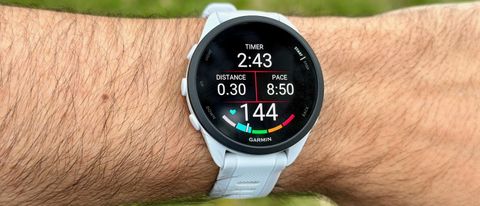Android Central Verdict
This isn't the first Garmin watch in the $250 range, but the Garmin Forerunner 165 feels like the first to nail the balance between cost-cutting measures and the quality tools of higher-end models. Only a particularly data-driven runner needs to pay extra for the Forerunner 265: the 165 delivers similar location and health accuracy, the same daily workout suggestions based on your fitness and fatigue, and a more readable AMOLED display than the cheap MIPs of the past.
Pros
- +
Proven GNSS and HRM accuracy in my tests
- +
Comfortable weight and band
- +
More readable AMOLED display
- +
Adds altimeter, compass, Training Effect
- +
Hundreds less than other Forerunners
Cons
- -
Must pay extra for music storage, wi-fi
- -
Doesn't support Training Load or Status
- -
Big-bezel display w/out Gorilla Glass
Why you can trust Android Central
When I began reviewing the Garmin Forerunner 165, I was worried that it would feel too much like a downgrade compared to my long-time Forerunner 965 watch. I told myself not to hold any shortcomings against it since Garmin designed it as a budget running watch.
Instead, I found that the Forerunner 165 outperforms its price; it hardly feels cheap at all.
Garmin's first attempts at sub-$300 watches with AMOLED displays — the Venu Sq 2 and Vivoactive 5 — put more emphasis on a mainstream design that appealed to non-Garmin fans. The Garmin Forerunner 165 looks cheaper, but it feels more like a watch built for Garmin fans who want to save some money, and it's that distinction why it's already on our list of the best Garmin watches today.
That being said, Garmin did disable a running feature on the Forerunner 165, most likely to make its $449 Forerunner 265 look more appealing. Whether you can save money with the 165 or not will depend on how much of a data-driven runner you are.
Garmin Forerunner 165: Price, models, and bands
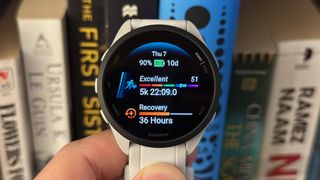
Released on February 20, 2024, the Garmin Forerunner 165 costs $249.99, while the Forerunner 165 Music costs $299.99. The latter version includes 4GB of music storage space and Wi-Fi support—the base 165 relies solely on Bluetooth—but has no other differences.
For context, the 165 Music has about 3.5GB of actual space for your Spotify, Deezer, or Amazon Music playlists — or your MP3 files. I could fit about 500 songs from my personal library via the Garmin Express desktop app. However, this will vary based on the size and quality of your music files. If you want more space, the Forerunner 265 Music has 8GB of storage, while the Forerunner 965 has 32GB for music and maps.
Both versions of the Forerunner 165 ship in Black or Mist Gray cases, with dual-tone Slate Gray or Whitestone silicone bands, respectively. Only the Forerunner 165 Music has more colorful options: a Berry case with a Lilac strap or a Turquoise case with an Aqua strap.
Garmin uses 20mm Quick Release bands for the Forerunner 165, meaning they're easily swapped out by pulling a tab. You can buy replacement straps of any color in silicone ($39.99 each), nylon ($69.99), or leather ($69.99) from Garmin directly, or look at third-party options.
Garmin Forerunner 165 specs
| Category | Garmin Forerunner 165 |
|---|---|
| Display | 1.2-inch (390 x 390) AMOLED touchscreen |
| Materials | Fiber-reinforced polymer, chemically strengthened glass |
| Strap | 20mm Quick Release silicone |
| Water resistance | 5ATM |
| Sensors | Elevate v4 HRM, Pulse Ox, accelerometer, altimeter, ambient light, compass |
| GPS tracking | GPS, GLONASS, GALILEO, All-systems GNSS |
| Connectivity | Bluetooth, ANT+; Music edition: Wi-Fi |
| Music storage | 4GB (Music edition only) |
| Battery life | 11 days; 19 hours (GPS); 17 hours (All-systems GNSS); 6.5 hours (All-Systems + music streaming) |
| Dimensions | 43 x 43 x 11.6mm, 39g/ 1.38oz |
| Sport modes | Running (Outdoor Track, Trail, Ultra, Treadmill, Indoor Track, Virtual), Hiking, Biking, Indoor Biking, Pool Swimming, Open Water Swimming, Walking, Pilates, Yoga, Strength, HIIT, Cardio, Elliptical Training, Stair Stepping, Floor Climbing, Tennis, Pickleball, Padel |
| Key features | Daily suggested workouts, Garmin Coach, Pacepro, Track running, Race adaptive training, Training Effect, Morning Report, Body Battery, Sleep monitoring, Nap detection, HRV Status, Recovery time, wrist-based running dynamics, Intensity Minutes, LiveTrack, Garmin Pay |
Garmin Forerunner 165: What you'll love
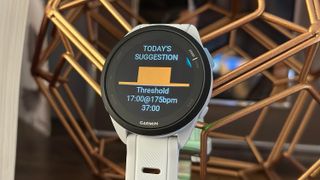
If you've owned a Garmin Forerunner watch before now, you generally know what to expect from the 165. It's easy to take Garmin's algorithm for granted, but you still won't find rival brands that can recommend a customized daily run that takes your current fitness and fatigue levels into account.
In my case, I rarely select daily suggested workouts like the one above because I like having a little flexibility without the Forerunner watch buzzing my wrist if I go off-pace. But it almost always inspires my choice of how hard to run and whether to stick to my neighborhood, jog to the track, or take a longer route loop.
To get this guidance in a $250 running watch with no monthly subscription is particularly special, knowing that most Garmin watches have the durability and post-launch software support to make them last for a few years, at least. Case in point, the 2015 Forerunner 235 and 2019 Forerunner 245 are still the most popular watches on Strava.
I predict that the Forerunner 165 could eventually take that spot for a number of reasons — starting, obviously, with the low price compared to most Garmin watches.
Prioritizes comfort, but still long-lasting
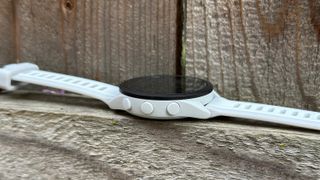
The Forerunner 965 has been my daily watch for about a year, and I've gotten used to its weight and thickness in exchange for the 23-day battery life and a 1.4-inch display. Once I switched to the Forerunner 165, which is half an ounce lighter and 1.6mm thinner, I suddenly remembered why I prefer lighter watches during long runs.
The Forerunner 165 design isn't what I'd call stylish, but that's true of most Garmins, and I care more that my wrist feels pleasantly light wearing it. I become more aware of the 965 whenever I hold my wrist up to check my pace, but the 165 falls out of my perception more quickly.
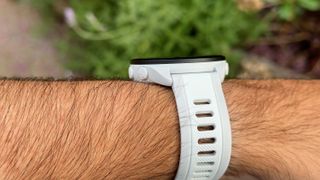
I'm also a fan of its lug-heavy silicone band for a secure and breathable fit that's not overly tight — even if I've noticed that the 965's silicone band seems slightly softer and more flexible. One could wish that Garmin offered a nylon upgrade at checkout instead of making you pay an extra $70, but I've gotten used to this moisture-wicking option.
The Forerunner 165's thin size and AMOLED display do affect its battery life, but I'll point out that plenty of past Forerunners like the 245 and 745 — which cost the same or more — only lasted a week per charge, despite the MIP displays. The Forerunner 165's 11-day battery with a more readable display is definitely an improvement, within the typical range for most cheap fitness trackers.
I'll admit that 17 hours of all-systems GNSS tracking is on the low side for a Garmin watch, and it does require more frequent charging than I've grown accustomed to with daily runs or walks. But it's about context: it'll still feel game-changing to non-Garmin users, there's no possible way it'll die on you during a race, and you can always pay for pricier Forerunners if the extra battery is a necessity.
Major upgrades over the Forerunner 55

If you own the Forerunner 55, Forerunner 745, or any other Forerunner more than a few years old, then the Forerunner 165 will feel properly next-generation, with hardware upgrades that any runner would appreciate.
For starters, you switch from a memory-in-pixel (MIP) non-touch display to a 1.2-inch AMOLED touchscreen with superior resolution — 390 x 390 versus 208 x 208 with the Forerunner 55. While this does cut three days of battery, I find that reading notifications and fitness charts without squinting becomes significantly easier, especially indoors, where MIP displays look dim unless you crank the backlight.
More importantly, you get the Elevate v4 sensor, which is capable of registering heart rate variability (HRV) for stress and more functional Body Battery recharge data. Yes, it's not the newer v5 sensor of the Venu 3 with ECG and skin temperature, but that's a tall ask for a cheaper watch. As far as I've seen in tests against chest heart rate straps, Garmin's v4 and v5 tech are comparable for core heart rate accuracy, and other (more expensive) Forerunners like the 965 use v4 as well.
The AMOLED display, accurate GNSS tracking, and reliable heart rate data make the Forerunner 165 feel truly next-gen compared to past Forerunners.
Plus, of course, Garmin gave the Forerunner 165 access to an all-systems GNSS mode that pulls from GPS, GALILEO, and GLONASS simultaneously. Having two satellite signals prevents inaccurate workout data in most contexts, even if it can't pinpoint quite as well as dual-frequency GPS on the pricier Forerunners. If you've made do with GPS-only up until now, you should appreciate the improved results (which I'll discuss in the next section).

The updates don't stop there: the Forerunner 165 has an altimeter for judging elevation gain, something missing from the Forerunner 55 and more recent Vivoactive 5. It's a must-have for runners since inaccurate elevation data means your watch can't attribute higher heart rates to hills, skewing your VO2 Max results.
In addition, if you like to download GPX files for offline courses, only the Forerunner 165 has a compass for breadcrumb navigation. There isn't enough room for topographical maps like the Forerunner 965 has, but Garmin treats that as a premium feature, so the 265 doesn't have this either.
On the software side, the Forerunner 165 isn't that different from the 55; plenty of my favorite Garmin training metrics require a 265 or 965 upgrade. You do, at least, see post-run Training Effect data showing its aerobic or anaerobic impact, and you can cross-train with indoor workouts.
You even get wrist-based running power and form analysis, which isn't especially helpful for amateurs unless you have a running coach or pro group to contextualize the data. I'm more grateful that the Forerunner 165 added audio prompts, shouting out mile times so you're not constantly checking your wrist.
Garmin Forerunner 165: GPS/ HRM accuracy test

Last month, I tested the Forerunner 165 against COROS and Fitbit trackers for GPS, elevation, step, and heart rate accuracy. I'm going to summarize the results here, along with some supplemental info.
For step count, it tracked 6,016 steps after 6,000 actual steps, tracked with a physical pedometer. The next closest was the COROS PACE 3 (91 steps above), with the Fitbit Charge 6 nearly 200 steps short of the actual total. It proved that the Forerunner 165 does the best for basic tracking if you're passionate about getting 10,000 steps a day.






For GPS accuracy, I weighed its All-Systems GNSS mode against the COROS PACE 3 dual-frequency mode, which (on paper) should be more accurate. My run maps above disabused this notion: my Garmin Forerunner 165 (pink) consistently stayed on the trail most of the time, while the COROS PACE 3 (orange) frequently strayed off the path. Their ultimate distance result — 5 miles for Garmin, 5.02 for COROS — wasn't that different, however.
(The Fitbit Charge 6's "Dynamic GPS," which combines results from its built-in satellite and my phone location data, was so erratic that I didn't bother cluttering my maps with the results).


During a subsequent mile-long track run in the third lane, the Garmin Forerunner 165 measured the correct 1,660-meter distance, while the actual GPS line had me drifting into left lanes before turns, filling the coverage gap. Again, COROS looked significantly worse on the map but had a similar distance total, while Fitbit's wonky GPS-only data (blue) was both inconsistent and 35 meters short.
Analyzing these results, it's clear that Garmin's mid-tier location tech is better than its rivals' top-tier results. I can't say whether Garmin's GPS-only watches are as unreliable as the Fitbit Charge 6 was, but assuming they are, your post-run pace and distance might be significantly off. The Forerunner 165 and its All-Systems GNSS could make a real difference in un-skewing your training data.

As for heart rate accuracy, you can check how the Forerunner 165 results compared to the Polar H10 chest strap across a five-mile run (above) and during a track workout (below).
For a standard run, the Forerunner 165 was consistently accurate for nearly the entire run, with the same average and minimum heart rates and only a 1 bpm difference for max heart rate. It kept up with the Polar H10 when my heart rate rose quickly on hills but did lag slightly at catching my falling heart rate on downhills.

For the track run, I alternated between sprints and jogs to see how well the Forerunner 165 could handle rapid changes in heart rate — a problem with wrist-based optical sensors.
The Forerunner 165 average bpm was only 1 bpm higher than the Polar H10, and the chest strap had a visible glitch with deflated results early in the workout, so I'd say they were very close. That said, you can definitely see how the Forerunner 165 lagged behind the Polar H10 during those sudden changes, both for heart rate increases and decreases.
I won't include the other heart rate charts here, but the Fitbit Charge 6 stayed mostly in lockstep with the chest strap during both runs, beating the Forerunner 165, while the COROS PACE 3 matched Garmin during the five-mile run but lagged even worse during the track run.
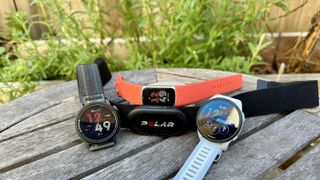
Overall, you can't fault these results in a $250 watch, especially the steps, elevation, and GPS distance.
Weeks of Forerunner 165 testing have me confident that it's as accurate for heart rate and GPS data as costlier running watches.
Only Fitbit does better in this price range for heart rate, but the poor location tracking offsets the benefits. I haven't found that the pricier Forerunners are any more accurate for heart rate, either, and even though the Forerunner 165 lags a bit for rapid heart rate changes, it averages out to the correct result in the end. If you want more accurate heart rate results than this, don't look at pricier running watches: Look at the Polar H10 or the COROS heart rate monitor.


For further context, I finished a 5K run of my neighborhood loop wearing the Forerunner 165 and 965 to check the gap in results between the $250 and $600 models. As you can see, my heart rate average was identical, a predictable but welcome result given that both use the Elevate v4 sensor.
Location accuracy is the minor sticking point. The Forerunner 165 measured an extra 0.02 miles after 3.1 miles, which skewed my pace by a second. It's fair to assume the Forerunner 965 is more accurate thanks to dual-frequency tracking, but it's also fair to note that this gap is minimal compared to GPS-only watches that'll be off by half a minute per mile.
Unless you frequently run near tall buildings or under dense foliage — which would make dual-frequency GPS especially helpful — I'd say that you can probably make do with the Forerunner 165's all-systems GNSS.
Garmin Forerunner 165: What you won't like

If you can't already tell, I really like the Garmin Forerunner 165, and I think most runners will, too. That said, it has plenty of compromises compared to the pricier models, with Garmin tantalizing you with missing features and cutbacks to upgrade to the 265.
On the design side, its polymer materials are rugged and lightweight, but you won't get an MIL-STD-810G rating like the Instinct 2X Solar, and its "chemically strengthened glass" isn't as scratch-proof as the 265's Gorilla Glass 3 treatment, nor as immune to reflections as the 965's Gorilla Glass DX.
More importantly, its plastic, button-heavy look isn't attractive; that also applies to other Forerunners, to be fair, but I want to make that clear for people who haven't grown accustomed to the Garmin aesthetic and prefer aluminum or steel casing.
Visually, the 1.2-inch display is bright enough, and since Garmin's UI doesn't do anything complicated, the Forerunner 165's thick bezel is more of an aesthetic issue than a functional one.
With its focus solely on health, sleep, and fitness tracking, the Forerunner 165 will feel substandard to anyone who likes powerful smartwatches like the Samsung Galaxy Watch 6, which costs $50 more and gives you a full series of apps, including third-party running apps like Strava or Nike Run Club.
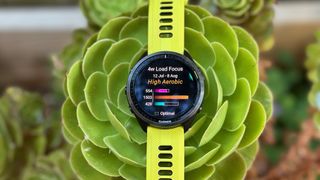
Moving away from general downgrades to missing Garmin features, the Garmin Forerunner 165 doesn't track training load or load focus. Technically, it can register post-run load, but you'll only see it in the Garmin Connect app if you own a pricier Forerunner like the 265 with training load data.
Training load matters because it helps me determine whether I'm over- or undertraining compared to past weeks and which type of run (low aerobic, high aerobic, or anaerobic) I need to do next to improve my VO2 Max over time. I wrote last month that this missing feature, purposefully excluded by Garmin, is the reason why I can't replace my Forerunner 965 with the 165.
Without Training Load and Status, it's harder to confirm if you're improving or deteriorating as a runner. This data can be enlightening or discouraging, and while data-driven runners will miss this, others will want to avoid the distraction.
Other absent features include Training Status, which essentially summarizes whether your fitness is improving based on your Training Load, and the corresponding VO2 Max chart showing your changing score in recent weeks. You also lose Training Readiness, which goes beyond your Body Battery and estimated recovery time to judge your stamina level before a workout. Even if you're fully recovered from your last run, you still might not be "ready" due to stress, poor sleep, or other factors.
I could continue to list features like Performance Condition, a lactate threshold test, multisport activities for triathletes, and others that only come with the Forerunner 265. In the end, you'll have to decide if you need all of these ancillary features, which would mean upgrading to the Forerunner 265.
Garmin Forerunner 165: Competition
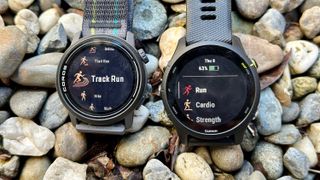
As should be obvious from reading this review, other Garmin Forerunner watches are the best competition to the Forerunner 165.
The Forerunner 255 and 265 cost $100 and $200 more, respectively. The Forerunner 255 gives you Training Status and Load data, plus dual-band GPS tracking and an extra three days of battery life; in exchange, you have to accept an MIP display. The Forerunner 265 has the same features with Training Readiness added, plus a 13-day battery life.
If you want to look outside of Garmin watches, the COROS PACE 3 is the most obvious rival. It costs $20 less, with tools like training plan calendars, post-run training effect, and recovery time that the Forerunner 165 has. Plus, it has the training status and training load data that Garmin restricts, a 24-day battery life, and a similar weight and size. Negatives include its cheap appearance and dull MIP display, along with the fact that it lost to the Forerunner 165 in my accuracy test.
Garmin Forerunner 165: Should you buy?
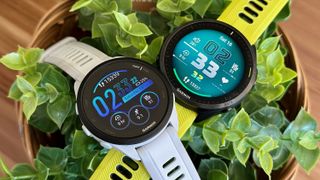
You should buy the Garmin Forerunner 165 if...
- You're a runner who needs personalized workout recs and accurate post-run data.
- You're using a last-gen Forerunner and want a hardware upgrade — but you're happy with the software.
- You can't afford the pricier Forerunners.
You shouldn't buy the Garmin Forerunner 165 if...
- You need Training Load data for your training schedule.
- You'd rather prioritize battery life over an AMOLED display.
Since I moved away from New York City and its many running clubs — right in time for a global pandemic — I've become more of a solitary, data-driven runner. The Garmin Forerunner 165 checks most of my boxes, mainly with its workout suggestions that take my fatigue, training load, and upcoming races into account.
Because I tested the Forerunner 265 and 965 first, I've become accustomed to seeing my training load data and VO2 Max graph for myself as a benchmark for whether I'm staying on track. But if I'd never used those watches, I wouldn't know what I was missing. I could simply download a Garmin marathon training plan to my calendar or use Garmin Coach and trust in my effort without needing an algorithm to prove my progress.
The Garmin Forerunner 165 will top my personal list of the best running watches of 2024, but I'd only be able to use it if I took a different philosophical approach to my running. Whether you buy it will depend on the same thing: If you don't need Training Load, then don't upsell yourself to a pricier Garmin, and buy the excellent Forerunner 165.
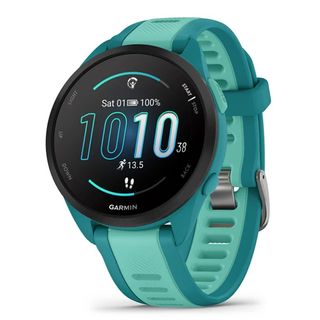
Best budget option
The Garmin Forerunner 165 is among the brand's most affordable options, and while that means accepting some compromises, plenty of runners will happily do so — especially if they've been using the Forerunner 55, 245, or other older models with last-gen software. The 165 upgrades the GPS & heart rate accuracy and adds useful new sensors like an altimeter and compass, while keeping the same core metrics and training tools.

Michael is Android Central's resident expert on fitness tech and wearables, with an enthusiast's love of VR tech on the side. After years freelancing for Techradar, Wareable, Windows Central, Digital Trends, and other sites on a variety of tech topics, AC has given him the chance to really dive into the topics he's passionate about. He's also a semi-reformed Apple-to-Android user who loves D&D, Star Wars, and Lord of the Rings.
For wearables, Michael has tested dozens of smartwatches from Garmin, Fitbit, Samsung, Apple, COROS, Polar, Amazfit, and other brands, and will always focus on recommending the best product over the best brand. He's also completed marathons like NYC, SF, Marine Corps, Big Sur, and California International — though he's still trying to break that 4-hour barrier.
